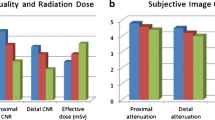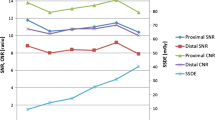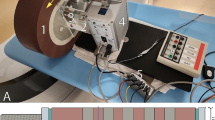Abstract
Objectives
To assess the influence of tube potential on radiation dose and image quality of third-generation dual-source coronary CT angiography (CTA) in a phantom simulating an obese patient.
Methods
A thoracic phantom was equipped with tubular inserts containing iodine solution and water. A soft-tissue-equivalent ring around the phantom simulated an obese patient. Images were acquired at tube potentials of 80, 100, 120 and 140 kV with second-generation dual-source CT (DSCT) and 70–150 kV (in 10-kV increments) with third-generation DSCT. Contrast-to-noise ratio (CNR) was calculated and CT dose index was recorded.
Results
With second-generation DSCT, CNR was highest for 120 kV (19.0) and decreased with lower tube potential (12.0 at 80 kV) owing to disproportionately increased image noise. With third-generation DSCT, 70- and 80-kV acquisitions showed a smaller increase in noise. CNRs for third-generation DSCT were highest for 70 and 80 kV (21.1 and 21.2, respectively). Compared to 120 kV, radiation dose was 68 % and 49 % lower at 70 kV and 80 kV, respectively.
Conclusion
Third-generation DSCT enables one to perform coronary CTA at 70–80 kV in obese patients without compromising CNR and thus reduces radiation dose by 49–68 %.
Key points
• Low tube potential CT angiography is currently not suitable for obese patients.
• Third-generation DSCT offers substantially increased tube power at low tube potential.
• This enables one to perform coronary CT angiography at 70–80 kV in obese patients.
• Signal-to-noise ratio is maintained owing to increased tube current.
• This approach can be expected to reduce radiation dose by 49–68 %.





Similar content being viewed by others
References
Hausleiter J, Martinoff S, Hadamitzky M et al (2010) Image quality and radiation exposure with a low tube voltage protocol for coronary CT angiography results of the PROTECTION II Trial. JACC Cardiovasc Imaging 3:1113–1123
Siemens (2014) SOMATOM Force. http://www.healthcare.siemens.com/computed-tomography/dual-source-ct/somatom-force. Accessed 2 Jan 2014
Winklehner A, Goetti R, Baumueller S et al (2011) Automated attenuation-based tube potential selection for thoracoabdominal computed tomography angiography: improved dose effectiveness. Invest Radiol 46:767–773
Ho JS, Barlow CE, Reinhardt DB, Wade WA, Cannaday JJ (2010) Effect of increasing body mass index on image quality and positive predictive value of 100-kV coronary computed tomographic angiography. Am J Cardiol 106:1182–1186
Lee AM, Engel LC, Hui GC et al (2013) Coronary computed tomography angiography at 140 kV versus 120 kV: assessment of image quality and radiation exposure in overweight and moderately obese patients. Acta Radiol. doi:10.1177/0284185113502745
Bischoff B, Hein F, Meyer T et al (2009) Impact of a reduced tube voltage on CT angiography and radiation dose: results of the PROTECTION I study. JACC Cardiovasc Imaging 2:940–946
LaBounty TM, Leipsic J, Poulter R et al (2011) Coronary CT angiography of patients with a normal body mass index using 80 kVp versus 100 kVp: a prospective, multicenter, multivendor randomized trial. AJR Am J Roentgenol 197:W860–W867
Ripsweden J, Brismar TB, Holm J et al (2010) Impact on image quality and radiation exposure in coronary CT angiography: 100 kVp versus 120 kVp. Acta Radiol 51:903–909
Cao JX, Wang YM, Lu JG, Zhang Y, Wang P, Yang C (2013) Radiation and contrast agent doses reductions by using 80-kV tube voltage in coronary computed tomographic angiography: a comparative study. Eur J Radiol. doi:10.1016/j.ejrad.2013.06.032
Jun BR, Yong HS, Kang EY, Woo OH, Choi EJ (2012) 64-slice coronary computed tomography angiography using low tube voltage of 80 kV in subjects with normal body mass indices: comparative study using 120 kV. Acta Radiol 53:1099–1106
Leschka S, Stolzmann P, Schmid FT et al (2008) Low kilovoltage cardiac dual-source CT: attenuation, noise, and radiation dose. Eur Radiol 18:1809–1817
Hou Y, Liu X, Xv S, Guo W, Guo Q (2012) Comparisons of image quality and radiation dose between iterative reconstruction and filtered back projection reconstruction algorithms in 256-MDCT coronary angiography. AJR Am J Roentgenol 199:588–594
Renker M, Nance JW Jr, Schoepf UJ et al (2011) Evaluation of heavily calcified vessels with coronary CT angiography: comparison of iterative and filtered back projection image reconstruction. Radiology 260:390–399
Yin WH, Lu B, Li N et al (2013) Iterative reconstruction to preserve image quality and diagnostic accuracy at reduced radiation dose in coronary CT angiography: an intraindividual comparison. JACC Cardiovasc Imaging 6:1239–1249
Wang R, Schoepf UJ, Wu R et al (2012) Image quality and radiation dose of low dose coronary CT angiography in obese patients: sinogram affirmed iterative reconstruction versus filtered back projection. Eur J Radiol 81:3141–3145
Renker M, Geyer LL, Krazinski AW, Silverman JR, Ebersberger U, Schoepf UJ (2013) Iterative image reconstruction: a realistic dose-saving method in cardiac CT imaging? Expert Rev Cardiovasc Ther 11:403–409
McCollough CH, Chen GH, Kalender W et al (2012) Achieving routine submillisievert CT scanning: report from the summit on management of radiation dose in CT. Radiology 264:567–580
Leipsic J, Heilbron BG, Hague C (2012) Iterative reconstruction for coronary CT angiography: finding its way. Int J Cardiovasc Imaging 28:613–620
Acknowledgements
The scientific guarantor of this publication is U. Joseph Schoepf, MD. The authors of this manuscript declare relationships with the following companies: Dr. Schoepf is a consultant for and receives research support from Bayer, Bracco, GE and Siemens. Mr. Canstein, Dr. Sedlmaier, Dr. Schmidt and Dr. Flohr are Siemens employees. The other authors have no conflict of interest to disclose. The authors state that this work has not received any funding. No complex statistical methods were necessary for this paper. Institutional review board approval was not required because this is a phantom study and does not involve human subjects. None of the study subjects or cohorts have been previously reported. Methodology: experimental phantom study, performed at one institution.
Author information
Authors and Affiliations
Corresponding author
Rights and permissions
About this article
Cite this article
Meinel, F.G., Canstein, C., Schoepf, U.J. et al. Image quality and radiation dose of low tube voltage 3rd generation dual-source coronary CT angiography in obese patients: a phantom study. Eur Radiol 24, 1643–1650 (2014). https://doi.org/10.1007/s00330-014-3194-x
Received:
Revised:
Accepted:
Published:
Issue Date:
DOI: https://doi.org/10.1007/s00330-014-3194-x




